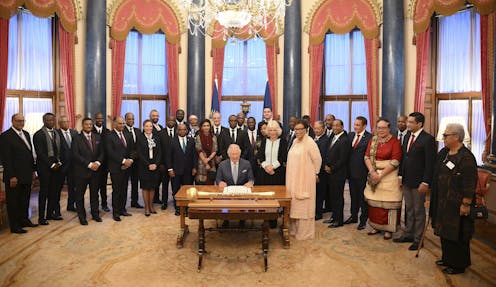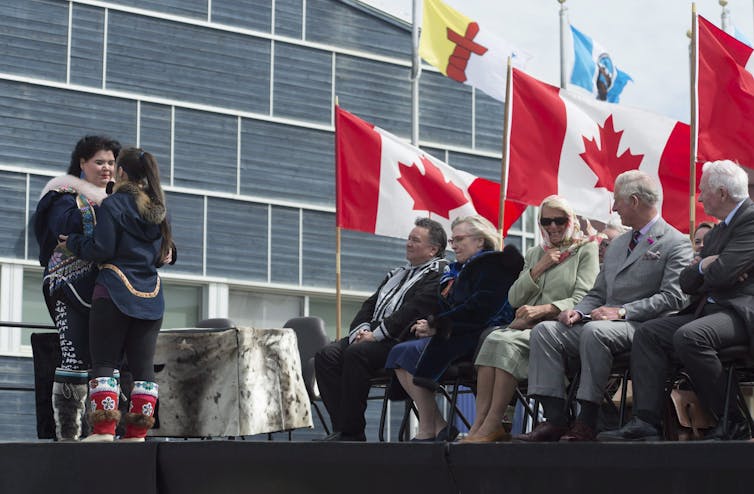
On May 6, 2023, eyes around the world will be on Westminster Abbey in London as King Charles and Queen Consort Camilla are crowned.
The coronation comes at a critical time for the monarchy. Fourteen Commonwealth countries, including Canada, still have the British sovereign as their head of state, but times are changing.
In 2021, Barbados became the latest Commonwealth country to drop the monarchy and become a republic. Jamaica has said it plans to explore the idea in the not-too-distant future.
The coronation is an important moment for King Charles to show the Commonwealth and the world that his reign will be modern, more efficient and more sensitive to the legacy of British imperialism.
A modern coronation
British coronations have been steeped in pomp and pageantry for centuries, with some ceremonial elements going back 1,000 years. But at a time when people in Britain and around the world are worried about the cost of living and war in Europe, an expensive coronation ceremony could seem insensitive and out of touch.
Buckingham Palace seems aware of these concerns. Media reports have indicated Charles might cut the ceremony down to just an hour and chop the VIP list from a whopping 8,000 guests down to 2,000.

In January, officials said the ceremony “will reflect the Monarch’s role today and look towards the future, while being rooted in longstanding traditions and pageantry.” Whatever else Charles decides to cut will further signal how he hopes to be perceived as King.
One message is already coming through. This is going to be a more personal, inclusive coronation than any before. The canopy that is held above Camilla’s head when she is anointed Queen will be carried by her five grandchildren.
Colonial past
The monarchy is also looking to be mindful of its pounds and pence on coronation spending. Last month, it was announced Camilla would wear Queen Mary’s Crown, made in 1911 for Charles’s great-grandmother. This is the first time since 1727 a previous queen’s crown is being reused. The palace says it’s doing so “in the interests of sustainability and efficiency.”
But the crown is also a visible reminder of Britain’s colonial past. Queen Mary’s Crown was designed to show off the Koh-i-Noor diamond. One of the oldest and most significant gemstones in Indian history, it was seen as an heirloom of power and the authority to rule. In 1849, the last Maharaja of the Sikh Empire “gifted” the diamond to Queen Victoria at the urging of the British colonial government in India.
The diamond eventually became part of the crown jewels. As a symbol of British imperial power, it was shown off in Queen Mary’s crown at the 1911 coronation of King George V.
For years, many have called for the Koh-i-Noor’s return. India’s solicitor-general claimed during a court case in 2016 that the diamond was “neither stolen nor forcibly taken away.”
The Indian government quickly backtracked on this. The culture ministry stated that it wanted to “bring back the Koh-i-noor diamond in an amicable manner.” Pakistan, Iran and Afghanistan have also claimed it at one time or another.
For the upcoming coronation, the Koh-i-Noor will be conspicuously absent from Queen Mary’s recycled crown. The Cullinan diamonds that were part of Queen Elizabeth II’s personal jewels will be used.
These stones were cut from the Great Star of Africa, the largest diamond ever found. It was purchased by the British colonial government in South Africa in 1905 and was added into the crown jewels.
Queen Elizabeth’s death in September 2022 has reignited calls for the return of both the Koh-i-Noor and the Cullinan diamonds. Such a move could have powerful ramifications for the monarchy, since India and South Africa remain members of the Commonwealth but without the King as head of state.
There are other signs the monarchy is looking to distance itself from its colonial past during the coronation festivities. On May 26, a special exhibit of the crown jewels is planned to open at the Tower of London.
The history of the Koh-i-Noor will be a major feature, and the exhibit promises to “explain the stone’s story as a symbol of conquest.” How that story will be presented remains to be seen.
Will the new King help build a more peaceful and inclusive Commonwealth? Will it even be possible for an aging white man, adorned in what to many are the symbols of repression, privilege and colonialism to do so?
Monarchists and critics alike will have to wait to see if the signals of progressive modernism surrounding the coronation develop into meaningful changes to the 1,000-year-old institution.
Justin Vovk receives funding from the Social Sciences and Humanities Research Council of Canada.
This article was originally published on The Conversation. Read the original article.







